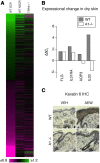The ion channel TRPA1 is required for chronic itch
- PMID: 23719797
- PMCID: PMC3752436
- DOI: 10.1523/JNEUROSCI.5318-12.2013
The ion channel TRPA1 is required for chronic itch
Abstract
Chronic itch is a debilitating condition that affects one in 10 people. Little is known about the molecules that mediate chronic itch in primary sensory neurons and skin. We demonstrate that the ion channel TRPA1 is required for chronic itch. Using a mouse model of chronic itch, we show that scratching evoked by impaired skin barrier is abolished in TRPA1-deficient animals. This model recapitulates many of the pathophysiological hallmarks of chronic itch that are observed in prevalent human diseases such as atopic dermatitis and psoriasis, including robust scratching, extensive epidermal hyperplasia, and dramatic changes in gene expression in sensory neurons and skin. Remarkably, TRPA1 is required for both transduction of chronic itch signals to the CNS and for the dramatic skin changes triggered by dry-skin-evoked itch and scratching. These data suggest that TRPA1 regulates both itch transduction and pathophysiological changes in the skin that promote chronic itch.
Figures






Comment in
-
Sensory systems: dissecting the mechanisms of chronic itch.Nat Rev Neurol. 2013 Jul;9(7):357. doi: 10.1038/nrneurol.2013.121. Epub 2013 Jun 18. Nat Rev Neurol. 2013. PMID: 23774856 No abstract available.
References
-
- Andoh T, Nagasawa T, Satoh M, Kuraishi Y. Substance P induction of itch-associated response mediated by cutaneous NK1 tachykinin receptors in mice. J Pharmacol Exp Ther. 1998;286:1140–1145. - PubMed
-
- Bánvölgyi A, Pozsgai G, Brain SD, Helyes ZS, Szolcsányi J, Ghosh M, Melegh B, Pintér E. Mustard oil induces a transient receptor potential vanilloid 1 receptor-independent neurogenic inflammation and a non-neurogenic cellular inflammatory component in mice. Neuroscience. 2004;125:449–459. doi: 10.1016/j.neuroscience.2004.01.009. - DOI - PubMed
Publication types
MeSH terms
Substances
Grants and funding
LinkOut - more resources
Full Text Sources
Other Literature Sources
Medical
Molecular Biology Databases
Research Materials
